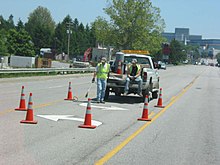Traffic cones
A traffic cone or traffic cone , also known as a pylon , is a traffic sign and shut-off device that is primarily used for short-term warning and protection of work , emergency and accident sites in public road traffic and is used to visually guide road users in this area. In addition to being used in road traffic, the traffic cone is also used in sports and leisure, such as for pylon lanes in motorsport .
Traffic cones are made of flexible plastic in different sizes and have a striking color. The surface can also be designed to be retro- reflective to improve night visibility . They are easy to transport, stackable and largely harmless in the event of a collision, as they can usually be driven over with almost no danger.
Definition
The term “traffic cone” is defined in the German road traffic regulations. There it belongs as sign 610 according to § 43 StVO i. V. m. Annex 4 StVO to the traffic facilities . In Austria or Switzerland, however, the term is not specifically defined in their traffic regulations.
In addition to the official designation, numerous other names have been used for this shut-off device, also depending on the intended use. Due to its characteristic shape, the traffic cone is often referred to as a pylon or traffic cone . The term warning cone is also used. The name Lübeck hat commemorates the place where the traffic cone was invented in 1952 . In 1968, the Molan company began to manufacture traffic cones made of thermoplastic material and in this way coined the term Molan cone . In Austria the term Hutterl or Haberkorn hat is common, which goes back to the company Haberkorn GmbH . By contrast, the Swiss call the traffic cones as Verkehrstöggel .
history
The traffic cone was invented in 1952 by Ewald Kongsbak. He then received a “federal utility model protection ”, but no patent , because there was already a similar product in the USA. Until 1952, red and white painted barrels weighted down with a stone were used in Germany to block lanes. In 1952 there was a fatal accident in which a car driver hit such a barrel. The force of the impact threw the stone through the windshield, killing the driver. This accident inspired Ewald Kongsbak to invent the Lübeck rubber hat with red and white horizontal stripes.
Shape and color
Traffic cones are used worldwide and often have a different shape and color due to the different norms and standards. Various (recycling) plastics are used for production, such as rubber , PVC or PE . Basically, the traffic cone consists of a stable base plate and a rising, conically shaped body. The footplate is significantly wider and heavier than the rising body. In this way, the traffic cone has a lower center of gravity and the risk of the cone tilting or slipping is reduced.
The surface of the traffic cone has a warning color and the rising body can be provided with one or more stripes to improve the contrast. For use in accordance with the StVO, a traffic cone consists of three red and two white rings. In order to improve night visibility, the strips are designed to be retroreflective . For use within the scope of the StVO, the entire surface of the traffic cone must be fully reflective. The color of the footplate can differ from the rising body.
The size and weight of the traffic cone depend on its intended use. For example, traffic cones with a height of 75 cm are used on motorways and expressways, on other roads those with a height of 30 and 50 cm - whereby the stripes can be dispensed with for the smallest traffic cones. Traffic cones with a height of 100 cm are used on roads in the rail area.
In order to reduce the space required by traffic cones that are not in use, foldable traffic cones are also produced and carried in emergency vehicles, for example.
Norms and standards
- Europe
- EN 13422 - "Vertical road signs. Portable deformable warning devices and delineators. Portable road traffic signs. Cones and cylinders "
- Germany
- Technical delivery conditions for traffic cones (TL traffic cones)
- Guidelines for Securing Workplaces on Roads (RSA 95)
Web links
Individual evidence
- ^ Molan employee magazine
- ^ Vorarlberg online - Claus Haberkorn nominated for the business curia
- ↑ 50 years of Lübeck hats
- ^ Graham Booth: World of Science, Volume 2 . Kogan Page Publishers, 1999, ISBN 0-19-914699-3 , pp. 49 .
- ↑ Surface reflection on www.tl-leitkegel.de
- ^ Department of Transportation: Manual on Uniform Traffic Control Devices . Claitor's Law Books and Publishing, 2003, ISBN 1-57980-929-4 , pp. 6F-30 .
- ↑ Traffic cone on www.rsa-95.de ( Memento of the original from February 2, 2012 in the Internet Archive ) Info: The archive link was inserted automatically and has not yet been checked. Please check the original and archive link according to the instructions and then remove this notice.








